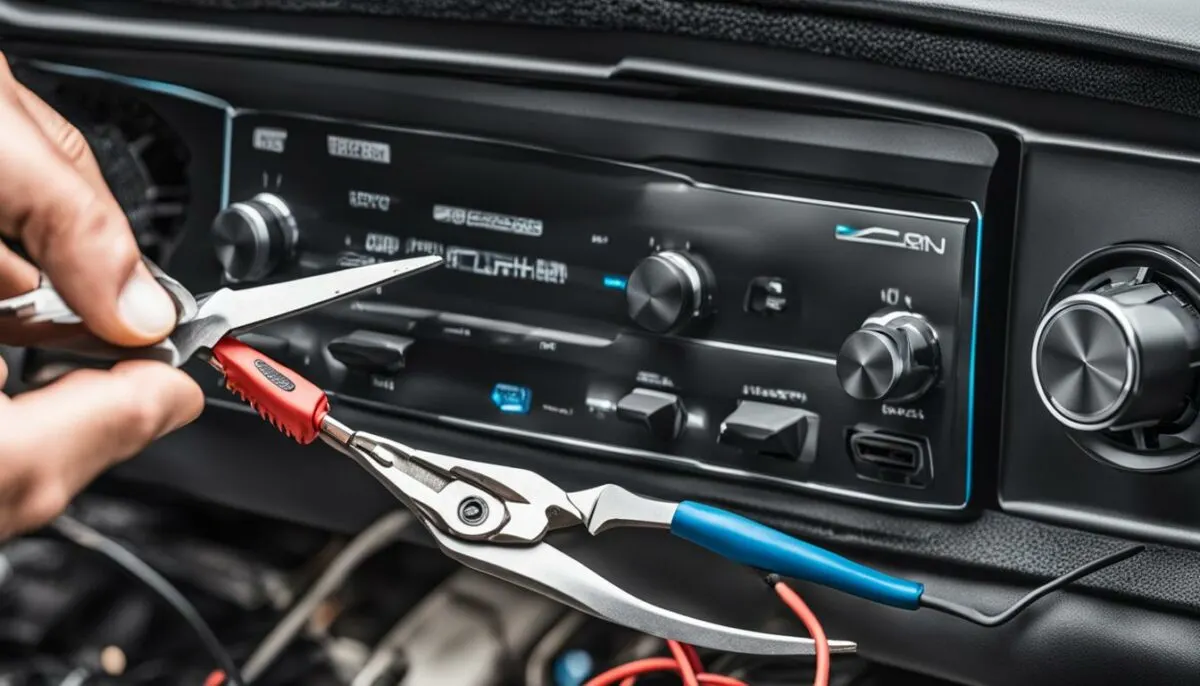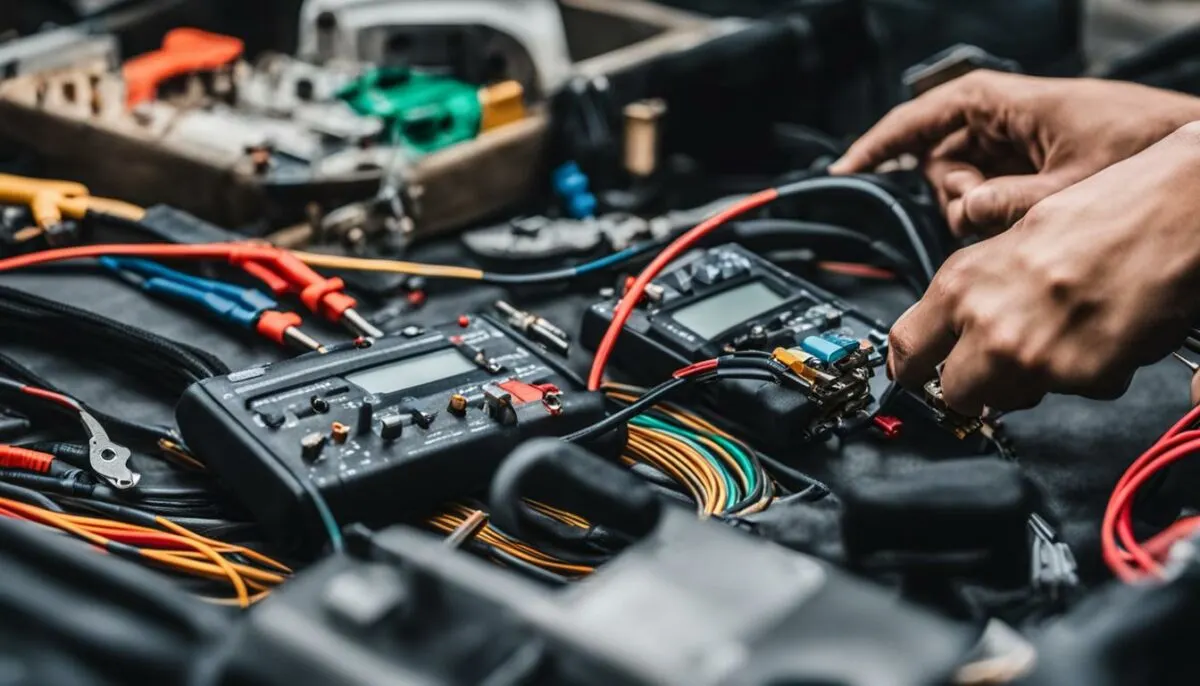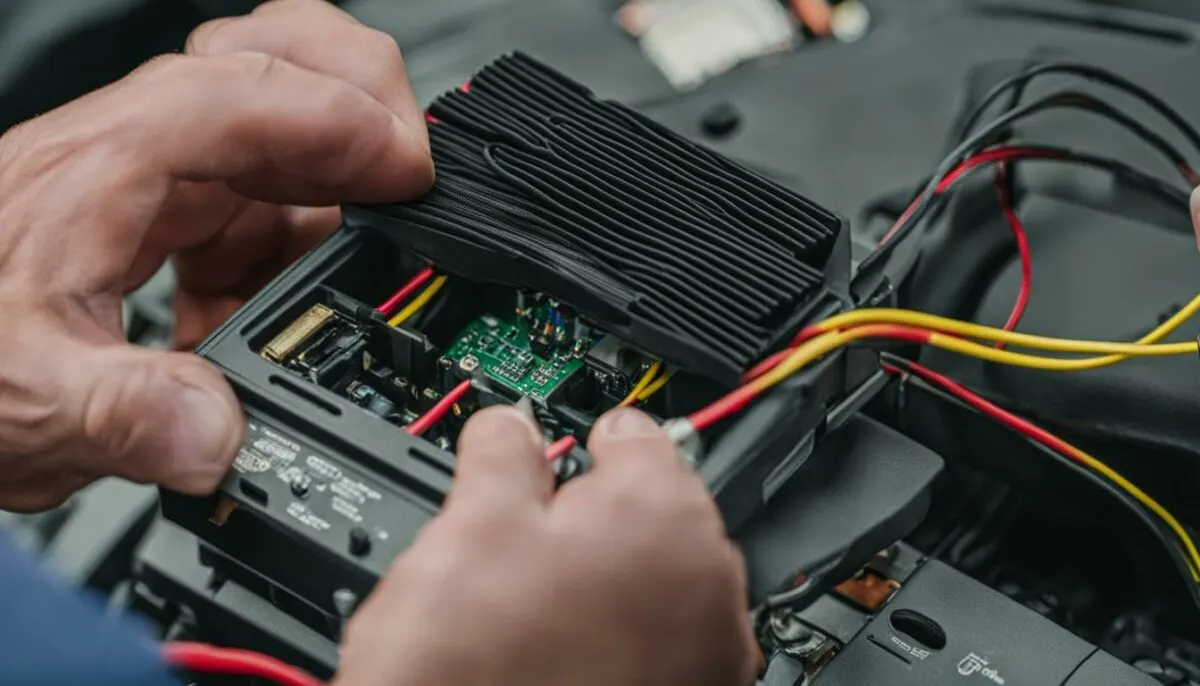Are you tired of listening to unwanted noise in your car audio system? Installing a noise filter is the perfect solution to enhance your listening experience. In this section, we will provide a comprehensive guide on how to install a noise filter in your car audio system. By following these step-by-step instructions, you can enjoy a clearer and richer sound in your car.
Before we dive into the installation process, it’s important to understand what noise filters are and how they work. We will explain the purpose of noise filters and why they are necessary for improving the audio quality in your car.
Key Takeaways:
- Installing a noise filter can significantly enhance the audio quality in your car.
- Understanding the purpose and function of noise filters is an important step in the installation process.
- By following our step-by-step guide, you can easily install a noise filter in your car audio system.
Understanding Noise Filters
When it comes to car audio systems, unwanted noise can be a frustrating problem. Noise filters are the solution to this issue and can significantly improve the audio quality in your car. In this section, we will explore what noise filters are and how they work.
What are Noise Filters?
Noise filters are electronic devices designed to remove unwanted noise from an audio signal. They work by analyzing the audio input and removing any frequencies that do not belong, resulting in a cleaner and clearer sound output.
Why are Noise Filters Necessary?
Noise can enter the car’s audio system in various ways, such as through the power wires, ground wires, or even the airwaves. This noise can result in a hissing, popping, or buzzing sound that can be distracting and unpleasant to listen to. A noise filter can effectively remove this unwanted noise and improve the overall audio quality in your car.
Installing a noise filter in your car audio system is a straightforward process that can be done with the right tools and guidance. In the following sections, we will provide a step-by-step guide on how to install a noise filter in your car audio system.
“Noise can enter the car’s audio system in various ways, such as through the power wires, ground wires, or even the airwaves.”
Noise Filter Installation Guide: Gathering the Necessary Tools
Before you begin installing your noise filter, you will need to gather a few tools and materials. Having everything ready beforehand will make the installation process much easier and smoother. Here’s what you will need:
| Tool/Material | Purpose |
|---|---|
| Screwdrivers | To remove panels or access points to your car’s wiring |
| Pliers | To crimp wire connectors and strip insulation |
| Wire Cutters | To cut and trim wires to the correct length |
| Heat Shrink Tubing | To cover and protect wire connectors |
| Electrical Tape | To secure wiring and prevent short circuits |
| Noise Filter | To eliminate unwanted noise from your car audio system |
Make sure to have the correct noise filter for your car audio system. Check the filter’s specifications to ensure compatibility with your vehicle’s audio system. Having the wrong noise filter can cause more harm than good.
Once you have all of your tools and materials, you’re ready to move onto the next step – locating the noise source.
Locating the Noise Source
The first step in installing a noise filter is to identify the source of the noise in your car audio system. By doing so, you can install the noise filter in the optimal location, allowing for maximum noise reduction.
One common source of noise is the alternator. Alternator noise is typically a high-pitched whine that increases in pitch as the engine revs up. Another source of noise can be the grounding of the car’s audio system, causing unwanted interference in the audio signal.
To locate the noise source, start by turning on your car audio system and playing music at a moderate volume. Next, turn your car’s engine on and increase the RPMs. Listen for any changes in the sound of the music. If you hear an increase in noise or interference, you have likely identified the noise source.
Another method for locating the noise source is to use a noise detector tool. This tool helps to pinpoint the exact location of the noise, making it easier to install the noise filter in the optimal location.
Example of a Noise Detector Tool
| Image | Description |
|---|---|
| The noise detector tool is a handheld device that helps to identify the source of noise in your car audio system. It works by amplifying the noise signal so that it is more easily detectable. |
Once you have located the noise source, you can proceed with installing the noise filter in the optimal location. This will vary depending on the specific source of the noise and the type of noise filter you are using, so be sure to follow the manufacturer’s instructions carefully.
Disconnecting the Battery

For safety reasons, it is crucial to disconnect the battery before proceeding with the car audio noise filter setup. Here are the steps to follow:
- Open the hood of your car and locate the battery. Refer to your car manual for specific instructions if needed.
- Use a wrench to loosen the negative (-) cable clamp that is connected to the battery. Ensure that the wrench does not touch any metal parts of the car.
- Remove the negative cable clamp from the battery terminal and secure it away from the battery.
- Repeat the same process for the positive (+) cable clamp.
Note: It is important to wrap the disconnected cable clamps with a cloth to prevent them from accidentally touching the battery terminals.
By doing this, you will ensure a safe and secure installation process.
Installing the Noise Filter:

Now that you have gathered all the necessary tools and located the noise source in your car audio system, it’s time to install the noise filter. Follow these noise filter installation tips:
- Read the instructions: Before proceeding with the installation process, carefully read the instructions that came with the noise filter. Not all filters are installed the same way, so it’s important to understand the specific requirements and steps for your particular model.
- Select a suitable location: Choose a suitable location for the noise filter. It should be close to the source of the noise and away from any heat sources.
- Connect the filter: Connect the noise filter to the car audio system by splicing the wires and soldering them together. Refer to the instructions for the specific wiring diagram for your particular model of noise filter.
- Use electrical tape: Once the wires are soldered together, use electrical tape to wrap around the connections to protect them from moisture, dust, and other potential damage.
- Secure the filter: Use zip ties or wire clamps to fasten the noise filter securely to a stable part of the car and prevent it from moving around.
For a more visual understanding, check out the following table highlighting the steps involved in installing a noise filter:
| Step | Description |
|---|---|
| Step 1 | Read the instructions carefully to understand your specific filter’s requirements and steps. |
| Step 2 | Choose a suitable location for the noise filter. |
| Step 3 | Connect the noise filter to the car audio system by splicing the wires and soldering them together. |
| Step 4 | Use electrical tape to wrap around the connections to protect them from potential damage. |
| Step 5 | Secure the noise filter in place with zip ties or wire clamps. |
Securing the Wiring

Once the noise filter is installed, it is crucial to secure the wiring properly to ensure a reliable and long-lasting connection. We recommend using cable ties to hold the wires in place, taking care not to overtighten them and damage the insulation on the wires.
When securing the wiring, it’s also essential to prevent any potential issues. Be sure to avoid routing wires near any moving parts, such as the pedals or steering column. Additionally, keep wires away from sources of heat, such as the engine or exhaust system, as they can damage the wires and pose a fire risk.
It’s also a good idea to cover any exposed wiring with electrical tape or split-loom tubing, providing an extra layer of protection against friction, abrasion, and moisture.
Here’s a quick summary of the steps to secure the wiring:
- Use cable ties to hold the wires in place.
- Ensure cable ties are not overtightened and do not damage insulation.
- Route wires away from moving parts and sources of heat.
- Cover exposed wiring with electrical tape or split-loom tubing.
Note: Always double-check your connections, particularly if you had to route wiring through tight spaces or under carpeting. Loose connections can lead to unwanted noise, reduced sound quality, and even damage to your car’s electrical system.
Reconnecting the Battery
After successfully installing the noise filter and securing the wiring, it’s time to safely reconnect the battery in your vehicle. Follow these steps:
- Insert the keys into the ignition and turn them to the “off” position.
- Connect the positive cable to the positive terminal on the battery.
- Tighten the cable with a wrench or pliers, being careful not to overtighten.
- Connect the negative cable to the negative terminal on the battery.
- Tighten the cable with a wrench or pliers, being careful not to overtighten.
Once the battery is reconnected, turn on your car and test the audio system to ensure everything is working correctly. If you encounter any issues, refer back to our troubleshooting tips in section 9.
Testing the Audio System

Now that you have successfully installed the noise filter, it’s time to test your car audio system and check the improvements brought by the filter. Here’s what you need to do:
- Turn on your car and the stereo system. Play music or any audio source with a low volume.
- Gradually increase the volume and pay attention to the sound quality. If the noise filter has been installed correctly, you should hear a noticeable reduction in unwanted noise and enjoy a clearer audio experience.
- If you notice any issues, such as distortion or unwanted noise, try adjusting the noise filter settings or double-checking the wiring connections.
It’s important to note that the noise filter may not completely eliminate all noise in your car audio system, especially if the source of the noise is located outside of the car. However, it should significantly reduce the noise and improve the overall audio quality.
As a tip, it’s recommended to test the audio system in different environments and driving conditions to ensure optimal performance of the noise filter.
Fine-Tuning the Noise Filter
After testing your car audio system with the newly installed noise filter, you may need to make some fine-tuning adjustments to optimize its performance further. Here are some tips and tricks on how to fine-tune your noise filter:
Adjusting the Crossover Frequency
Some noise filters have adjustable crossover frequencies that allow you to filter out specific frequencies that are causing noise in your audio system. You can adjust the crossover frequency by turning a knob or using a screwdriver. Start by setting the crossover frequency to the lowest setting and gradually increasing it until you hear the noise disappear.
Adjusting the Gain Level
The gain level is the strength of the audio signal after passing through the noise filter. You can adjust the gain level to fine-tune the audio quality further. Some noise filters have adjustable gain levels; others have fixed gain levels. If your noise filter has an adjustable gain level, start by setting it to the default level and gradually increasing or decreasing it until you achieve the desired audio quality.
Consulting the User Manual
If you are unsure about how to fine-tune your noise filter, consult the user manual that came with the product. The manual should have detailed instructions on how to adjust the various settings and optimize the performance of the noise filter.
Remember, fine-tuning your noise filter may require some trial and error. Take your time and experiment with different settings until you find the optimal configuration that suits your listening preferences.
Conclusion
If you want to improve your car audio system and get rid of unwanted noise, installing a noise filter is the way to go. By following our comprehensive guide on how to install a noise filter in your car audio system, you can do it yourself and save money while getting the desired results.
Remember, before you start the installation process, you should understand what noise filters do and how they work. You should also gather all the necessary tools and materials and locate the noise source in your car audio system.
The installation process involves disconnecting the battery, installing the noise filter, securing the wiring, and reconnecting the battery. Once you have completed the installation, you should test your car audio system and fine-tune the noise filter settings for optimal audio quality.
With our step-by-step guide, you can install a noise filter in your car audio system with ease. So, what are you waiting for? Get started today and enjoy a clearer and enhanced listening experience while driving!
SEO Keywords:
how to install noise filter car audio
noise filter installation tutorial
DIY noise filter installation
installing a noise filter in car audio system
FAQ
How long does it take to install a noise filter in a car audio system?
The installation time may vary depending on your experience and familiarity with car audio systems. On average, it can take anywhere from 1-2 hours to complete the installation.
What tools do I need to install a noise filter?
To install a noise filter, you will typically need the following tools: wire cutters, wire strippers, electrical tape, crimping tool, soldering iron (optional), and a screwdriver set.
Can I install a noise filter myself, or do I need professional help?
Installing a noise filter can be done by yourself if you have a basic understanding of car audio systems and the necessary tools. However, if you are unsure or uncomfortable with the installation process, it is recommended to seek professional assistance to avoid any potential damage.
Where should I install the noise filter in my car audio system?
The noise filter should be installed as close to the source of the noise as possible. In most cases, it is recommended to connect the noise filter directly to the power supply of the car audio system, typically near the head unit.
Will installing a noise filter completely eliminate all noise in my car audio system?
While a noise filter can significantly reduce unwanted noise, it may not completely eliminate all noise in your car audio system. Factors such as the quality of your audio equipment and the surrounding environment can also contribute to noise levels.
Can I use multiple noise filters in my car audio system?
It is possible to use multiple noise filters in your car audio system, especially if you have multiple sources of noise. However, it is important to ensure proper installation and wiring to avoid any interference or compatibility issues.
What are the benefits of installing a noise filter in my car audio system?
Installing a noise filter can provide several benefits, including improved audio quality, reduced background noise, enhanced clarity, and a more enjoyable listening experience overall.
Can I remove the noise filter if I no longer need it?
Yes, you can remove the noise filter from your car audio system if you no longer need it or if you experience any issues. Simply disconnect the wiring and remove the filter from its installation location.